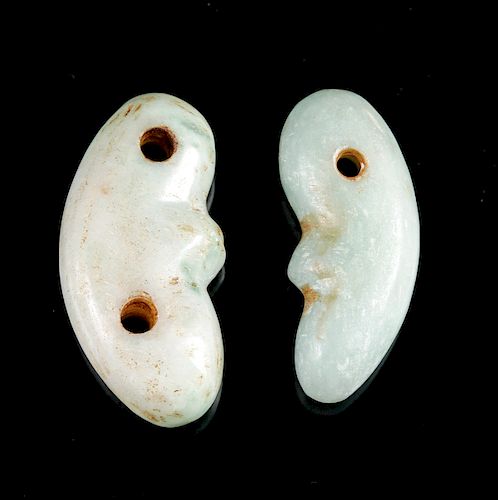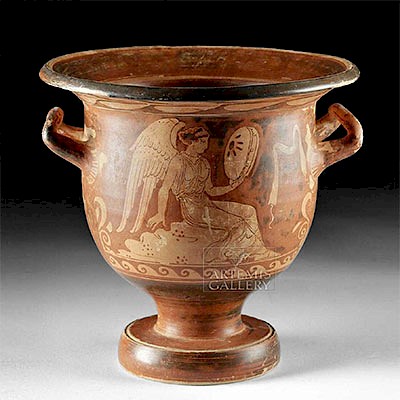Japanese Kofun Jadeite Magatama Amulets
Lot 145a
About Seller
Artemis Fine Arts
686 S Taylor Ave, Ste 106
Louisville, CO 80027
United States
Selling antiquities, ancient and ethnographic art online since 1993, Artemis Gallery specializes in Classical Antiquities (Egyptian, Greek, Roman, Near Eastern), Asian, Pre-Columbian, African / Tribal / Oceanographic art. Our extensive inventory includes pottery, stone, metal, wood, glass and textil...Read more
Categories
Estimate:
$800 - $1,200
Absentee vs Live bid
Two ways to bid:
- Leave a max absentee bid and the platform will bid on your behalf up to your maximum bid during the live auction.
- Bid live during the auction and your bids will be submitted real-time to the auctioneer.
Bid Increments
| Price | Bid Increment |
|---|---|
| $0 | $25 |
| $300 | $50 |
| $1,000 | $100 |
| $2,000 | $250 |
| $5,000 | $500 |
| $10,000 | $1,000 |
| $20,000 | $2,500 |
| $50,000 | $5,000 |
| $100,000 | $10,000 |
| $200,000 | $20,000 |
About Auction
By Artemis Fine Arts
Mar 7, 2019
Set Reminder
2019-03-07 10:00:00
2019-03-07 10:00:00
America/New_York
Bidsquare
Bidsquare : VARIETY SALE | Antiquities & Ethnographic Art
https://www.bidsquare.com/auctions/artemis-gallery/variety-sale-antiquities-ethnographic-art-3928
Around the world & back in time - be amazed at the treasures you will find. Antiquities from Egypt, Greece, Italy and the Near East, Asian, Pre-Columbian, African / Tribal / Oceanic, Native American, Spanish Colonial, Russian Icons, Fine Art, much more! Artemis Fine Arts info@artemisfinearts.com
Around the world & back in time - be amazed at the treasures you will find. Antiquities from Egypt, Greece, Italy and the Near East, Asian, Pre-Columbian, African / Tribal / Oceanic, Native American, Spanish Colonial, Russian Icons, Fine Art, much more! Artemis Fine Arts info@artemisfinearts.com
- Lot Description
East Asia, Japan, Kofun Period, ca. 250 to 538 CE. A pair of elegant jadeite pendants known as magatama meaning "sacred jewel". Both are finely carved in a classic comma shape. The one with a single perforation drilled through the widest end boasts milky white hues with hints of green. The other pendant with two perforations - one drilled through each end - presents in very pale seafoam green hues. Both have pleasing heft in the hand and would make lovely pendants. Size: the larger example (with 2 drilled perforations) measures 1.875" L (4.8 cm)
The reason for the comma-shaped form of the magatama is unknown, but there are several suggestions from researchers. Some suggest that the shape was inspired by animal fangs or the shape of a crescent moon. In addition, these forms are referenced in Japanese 8th century literature as gifts given by the gods to one another. Magatama from this period were owned as noble regalia by the chieftainships that controlled small areas of Kofun Japan, and they are often found in mounded tumulus graves, which has led modern researchers to interpret them as offerings to the gods. They were replaced in the public consciousness by Buddhist prayer beads in the Nara period, and represent an earlier period of religious worship than Buddhism in Japan. The Kofun period was when the foundations of feudal Japan were laid, and the Shinto religion, with its ritual practices and multitudinous nature gods, was celebrated as a unifying and uniquely Japanese practice.
Provenance: private Chicago, Illinois, USA collection
All items legal to buy/sell under U.S. Statute covering cultural patrimony Code 2600, CHAPTER 14, and are guaranteed to be as described or your money back.
A Certificate of Authenticity will accompany all winning bids.
We ship worldwide and handle all shipping in-house for your convenience.
#132865Both are intact. Surfaces are in nice age worn condition. Areas of deposits particularly evident in drilled openings.Condition
- Shipping Info
-
All shipping is handled in-house for your convenience. Your invoice from Artemis Gallery will include shipping calculation instructions. If in doubt, please inquire BEFORE bidding for estimated shipping costs for individual items.
-
- Buyer's Premium



 EUR
EUR CAD
CAD AUD
AUD GBP
GBP MXN
MXN HKD
HKD CNY
CNY MYR
MYR SEK
SEK SGD
SGD CHF
CHF THB
THB














